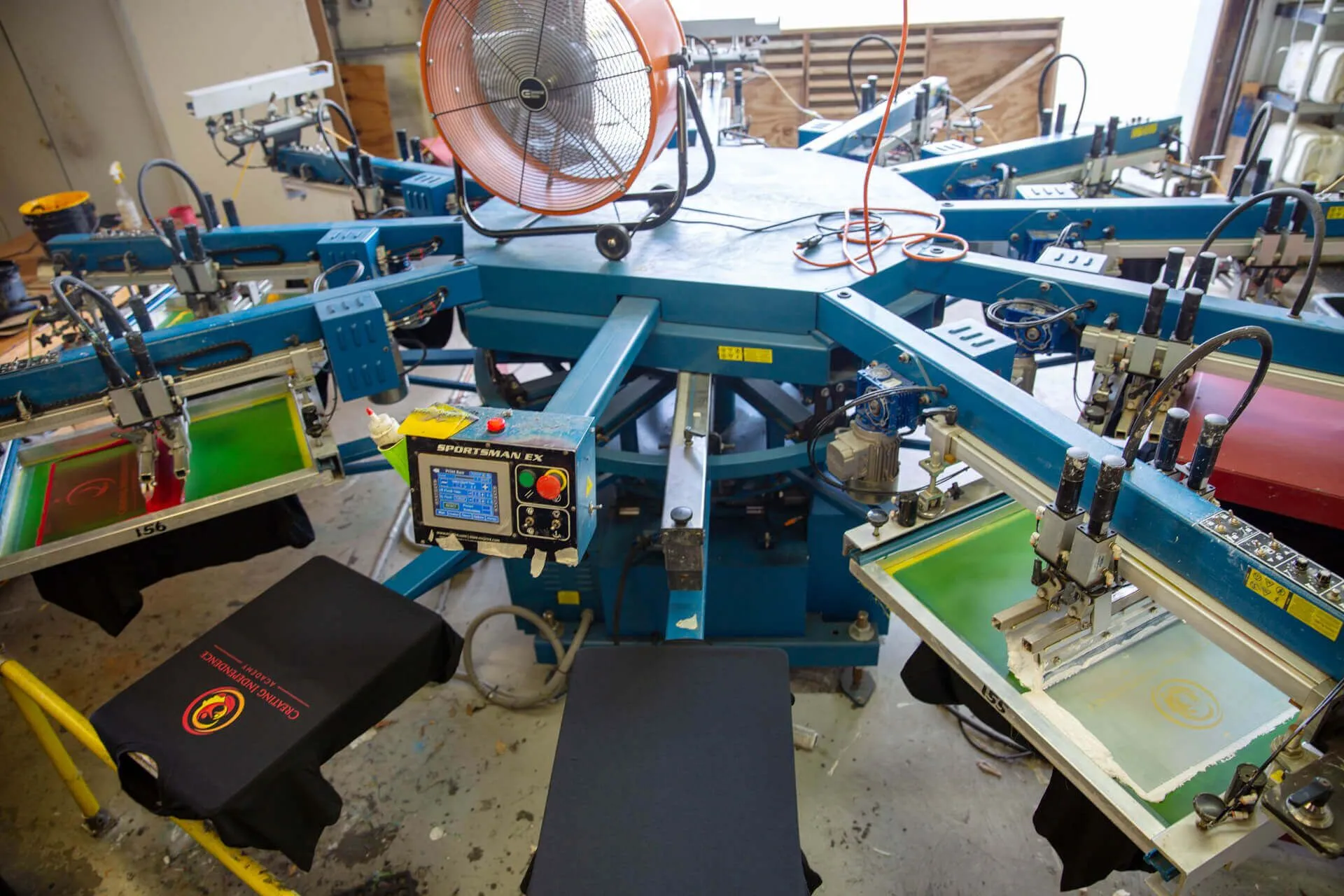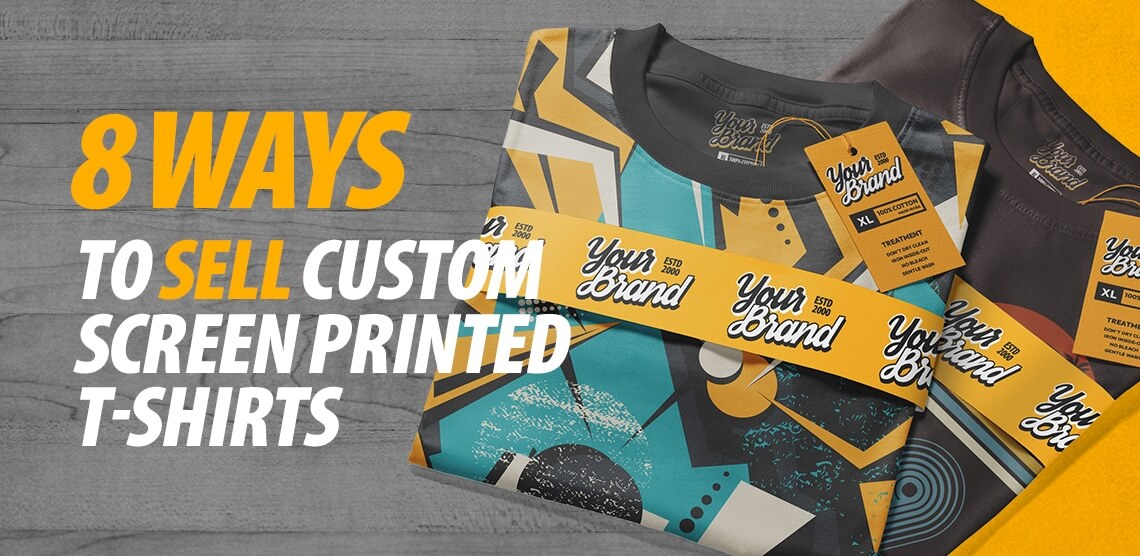Detailed Silk Screen Printing for Custom Art Apparel
Detailed Silk Screen Printing for Custom Art Apparel
Blog Article
Screen Printing Uncovered: Every Little Thing You Required to Understand About T-Shirt and Garment Printing Methods
Screen printing is an interesting approach that combines art with method, providing endless possibilities for creativity. Prepared to explore the crucial aspects that make screen printing an art form?
The Essentials of Display Printing: How It Functions
When you dive right into display printing, you'll find it's both a science and an art. At its core, screen printing entails developing a pattern, or screen, that permits ink to go through only in certain locations (screen printing kit). You start by choosing your layout and preparing your display with a light-sensitive emulsion. As soon as you expose this solution to light, it sets, leaving your design as an unfavorable space.
Next, you'll mix your inks and prepare your printing surface. Position the screen over the material, then use a squeegee to press ink via the screen onto the garment. This process calls for precision, as you desire clear, dynamic prints. After printing, you'll cure the ink with heat, ensuring it adheres to the fabric and lasts through washes. Each step is essential, and mastering them will certainly elevate your screen printing abilities, transforming basic garments right into one-of-a-kind, expressive items.
Kinds Of Screen Printing Strategies
When you comprehend the essentials of display printing, it's time to explore the different strategies that can raise your styles. One popular technique is traditional screen printing, where ink is pushed via a stenciled display. This technique is fantastic for bold, dynamic colors. There's water-based ink printing, which supplies a softer feel and is eco-friendly, yet it requires a various method to curing.
If you're aiming for fine details, consider discharge printing. This strategy gets rid of dye from the fabric, leaving a soft, vintage appearance. Another option is plastisol printing, recognized for its resilience and dazzling colors, making it a preferred for numerous brand names. Experiment with halftone printing to create slope results and detailed styles. Each technique has its one-of-a-kind appeal, so do not wait to try them out to find what matches your design best!
Crucial Tools for Display Printing
To achieve sensational results in screen printing, having the appropriate equipment is basic. You'll need a tough display printing frame, which holds the mesh that transfers your layout onto the garment. Next, spend in premium squeegees; these are important for using ink equally throughout the display.
Picking the Right Inks and Products
When selecting inks and materials for screen printing, you need to consider the sort of ink that functions ideal for your job. Assume regarding fabric compatibility to ensure your designs look terrific and last long. Also, check out environment-friendly ink choices to make your printing procedure more sustainable.
Types of Display Inks
Choosing the right screen ink is necessary for achieving vivid, sturdy prints that fulfill your job's needs. There are numerous kinds of screen inks to analyze. Specialty inks, such as metallic or glow-in-the-dark, can include unique impacts to your styles.

Material Compatibility Factors To Consider
Recognizing fabric compatibility is essential for attaining top notch display prints, particularly considering that various materials respond distinctly to numerous inks. Always check your inks on example fabric to assure they stick appropriately and maintain shade honesty. In addition, maintain in mind that material weight and texture can affect the last result, so picking the appropriate ink and product combo is important for your task's success.
Eco-Friendly Ink Options
Eco-friendly inks are ending up being a popular choice for display printers that desire to reduce their ecological effect while keeping high quality. When picking inks, consider water-based inks, which are much less damaging and much easier to cleanse up contrasted to traditional solvents.
In addition, try to find inks made from eco-friendly resources, such as soy or vegetable-based options. By picking the ideal inks and materials, you'll not just produce spectacular styles however also add to a more sustainable printing procedure. Make the switch, and your prints will mirror your dedication to the atmosphere!
Preparing Your Style for Display Printing

Submit Style Demands
To guarantee your style looks vibrant and sharp on fabric, you'll require to pay close attention to submit format demands for screen printing. Start with vector documents like AI or EPS, as they can be scaled without shedding quality. If you make use of raster images, select high-resolution files, such as TIFF or PNG, ideally at 300 DPI. Stay clear of making use of JPEGs, as they can shed clearness when resized. Also, ensure your design has a clear background to prevent undesirable white sides on your prints. Maintain shade settings in mind; CMYK is basic for display printing, so convert your RGB develops accordingly - screen printing kit. By following these guidelines, you'll set your art work up for a successful print.
Color Splitting Up Techniques
Shade separation is an essential action in preparing your layout for screen printing, and grasping it can considerably enhance your print high quality. You'll need to silk screen printing damage your style into private shades, as each shade calls for a different screen throughout printing. Begin by identifying all the shades in your layout and develop layers for each one. You can make use of software like Adobe Photoshop or Illustrator to separate and different colors efficiently. Be specific to save each layer as a separate file, commonly in a format like TIFF or PSD. This precision not just assures exact color depiction however also enhances the printing process. By taking note of shade separation, you'll accomplish specialist and dynamic lead to your screen-printed garments.
Resolution and Size
Accomplishing the very best lead to screen printing starts with assuring your layout has the ideal resolution and size. Ideally, your art work should go to least 300 DPI (dots per inch) for sharp, clear prints. Your last item might look less than professional and pixelated. if you utilize lower resolution.
When it pertains to size, think about the measurements of your print location. Layout your art work to match the last print size, ideally creating it in the actual dimensions you'll be publishing. By doing this, you'll stay clear of any unexpected scaling issues.
Always check your layout in both vector and raster formats. Vector graphics can be scaled without losing quality, making them excellent for screen printing. Preparing appropriately will ensure your style looks amazing on every garment!
Step-by-Step Display Printing Refine
Display printing is a dynamic process that allows you to produce lively styles on different surfaces. To get begun, you'll need a screen, emulsion, and your selected ink. Prepare your display by cleansing it thoroughly. Next, use the solution equally and let it dry in a dark location. As soon as dry, expose your screen to light with your layout put on it, which will certainly set the solution where the light hits, developing a stencil - screen printing kit.
Pour ink onto the display and make use of a squeegee to press the ink with the pattern onto the textile. Lift the display meticulously and let the print dry. You've effectively screen printed your style.
Tips for Successful Screen Printing Projects
While you're diving right into your screen printing jobs, keep in mind that prep work is vital to success. Beginning by gathering all your materials-- inks, screens, mops, and garments. A clean work space helps prevent unwanted mistakes, so clean prior to you begin.
Following, validate your art work is high-resolution and appropriately sized for your garment. Examine your display for proper exposure and clean it completely to prevent smudges. When mixing your inks, adhere to the producer's guidelines to accomplish the best uniformity.
During printing, apply also stress with your squeegee for consistent outcomes. Don't hurry; take your time to validate each print fulfills your standards. After printing, allow your garments dry totally before managing or packaging them.
Last but not least, always keep a sample of your help future reference. This way, you can evaluate your progression and boost your methods over time. Delighted printing!

Regularly Asked Concerns
How much time Does It Require To Establish a Screen Printing Job?
Establishing a display printing job usually takes around half an hour to an hour. You'll prepare the displays, mix inks, and readjust the press. The moment differs based on intricacy and experience, so remain organized!
Can I Publish on Different Material Keys In Using the Exact Same Technique?
Yes, you can print on different textile types making use of the same technique, yet you'll need to change your setups and inks. Some textiles soak up ink differently, so exploring assurances the very best results for each and every product.
What Are Common Errors to Prevent in Screen Printing?
When screen printing, avoid usual mistakes like making use of the incorrect ink, ignoring appropriate direct exposure times, or avoiding pre-press checks. Always examine your arrangement and maintain clean screens to ensure top quality results each time.
How Can I Effectively Clean and Keep My Display Printing Equipment?
To properly tidy and maintain your display printing equipment, you need to frequently clean displays with suitable solvents, examine squeegees for wear, and ensure all tools are saved dry and dust-free. Consistency improves and stops expensive repair work performance.
Is Screen Printing Eco Friendly Compared to Various Other Approaches?
Screen printing can be a lot more eco-friendly than other approaches, particularly if you utilize eco-conscious products and water-based inks. By choosing lasting supplies and practices, you reduce waste and reduce your effect on the world.
Screen Printing Uncovered: Everything You Need to Know Regarding T-Shirt and Garment Printing Methods
At its core, screen printing entails producing a pattern, or display, that enables ink to pass via only in certain locations. Placement the display over the material, after that use a squeegee to press ink with the screen onto the garment. One prominent technique is typical screen printing, where ink is pressed through a stenciled display.When picking inks and materials for display printing, you need to take right into account the type of ink that works best for your project.
Report this page